Published
on 26
Jun 2004
|
All rights reserved.
|
|
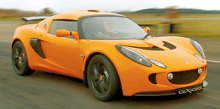 Exige
can be seen as a track-biased Elise, fulfilling those who drive their
cars
to work on weekdays and race their cars on "track days". Based on the
same
mechanicals as Elise 111R, i.e., the 192hp Toyota Celica engine and
6-speed
gearbox, the Exige received some aggressive treatment. Most obvious is
the addiiton of a composite roof and fastback engine lid, whose purpose
is to reduce air turbulence and lift of the open cockpit. A black lip
spoiler
and black rear wing spoiler help generating 19kg and 21kg downforce
front
and rear respectively at 100mph. Engine cooling is also enhanced by
larger
side intakes and an additional air scoop at the roof. Exige
can be seen as a track-biased Elise, fulfilling those who drive their
cars
to work on weekdays and race their cars on "track days". Based on the
same
mechanicals as Elise 111R, i.e., the 192hp Toyota Celica engine and
6-speed
gearbox, the Exige received some aggressive treatment. Most obvious is
the addiiton of a composite roof and fastback engine lid, whose purpose
is to reduce air turbulence and lift of the open cockpit. A black lip
spoiler
and black rear wing spoiler help generating 19kg and 21kg downforce
front
and rear respectively at 100mph. Engine cooling is also enhanced by
larger
side intakes and an additional air scoop at the roof.
As
for chassis, the Exige rides on 10% stiffer suspension setting than the
Elise 111R. But most significant is the adoption of Yokohama A048
semi-slick
tires, which give it superior grip on track. The new Exige corners
quicker
and flatter than the Elise, especially at higher speed where downforce
starts digging in. When it slide, the Yokohama tires keep that happen
progressively,
therefore oversteering is confidence inspiring. Compare with the first
generation Exige, it rides more supple, handles more tidy and is
quieter
in the cockpit. Besides, standard ABS and power steering make it easier
to live with.
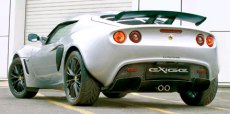 Nevertheless,
I suspect Exige is slower than the equivalent Elise, as the additional
bodywork adds 15kg to the kerbweight. Lotus claims the same
acceleration
figures and a slightly lower top speed at 147mph, blame to the drag
generated
by the rear spoiler. Nevertheless,
I suspect Exige is slower than the equivalent Elise, as the additional
bodywork adds 15kg to the kerbweight. Lotus claims the same
acceleration
figures and a slightly lower top speed at 147mph, blame to the drag
generated
by the rear spoiler.
The
problem is, the second generation Exige differs not that much from the
Elise and does not deserves a separate label. If you remember, the
first
generation Exige had wider tracks, stronger engine, a more diversified
look and a far sportier character to distinguish it from the
contemporary
Elise. Now this Exige is just an extension of the Elise range. |
Verdict:     |
Published on 25
Apr 2006
|
All rights reserved.
|
|
Exige S
|
Since
2 years ago we have been questioning why the second generation Exige
differed so little from the Elise, even sharing the same power plant.
Now Lotus finally gave us an answer: a supercharged version of the
Toyota 1.8 engine. The intercooled Roots type supercharger boosts
horsepower count from 192 to 218 at the same 7800 rpm. More crucially,
it sorted out the biggest problem of the high-revving VVTL-i engine:
torque. It lifts peak torque from 133 lbft to 159 lbft while lowering
its occurrence from 6800 rpm to 5500 rpm. This mean the power band
becomes stronger yet easier to access. Moreover, from 2000 rpm there is
already 80% of the maximum torque available, so the torque curve is not
only shifted towards the center of rev range, but also flattened a lot.
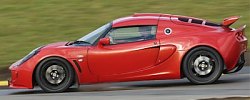 With the
new engine, the resultant Exige S can accelerate from rest to 60 mph in
merely 4.1 seconds, and then 100 mph at 9.8 seconds. This edge out the
late Esprit V8 to be the company’s fastest production car ! Top speed,
however, is merely 148 mph because of the high downforce shape and the
relatively modest top end power. With the
new engine, the resultant Exige S can accelerate from rest to 60 mph in
merely 4.1 seconds, and then 100 mph at 9.8 seconds. This edge out the
late Esprit V8 to be the company’s fastest production car ! Top speed,
however, is merely 148 mph because of the high downforce shape and the
relatively modest top end power.
If the existing Exige is a performance bargain, then Exige S is even
more impressive as a giant killer. Its UK price of £34,000 is
equivalent to a base Porsche Boxster 2.7, but its performance runs neck
to neck with a 996 GT3 RS in the real world.
As always, the handling of Exige S is sensational, thanks to the
ultra-lightweight chassis, tremendous grip from the Yokohama A048
semi-slick tires, massive downforce and the excellent tuning by Lotus.
Its track performance is amazing, because it was born as a part-time
racer - see the massive spoilers and the roof-mounted air intake and
you'll know. Moreover, it has adjustable dampers all round. At track
setting, the suspensions provide sharp and roll-resisting handling. At
road setting, they provide superb damping in the tradition of Elise, so
the Exige S feels at home on B-roads.
Such double-edge quality has always been a unique feature of the Elise
family. Now Exige S has added accessible power and even supercar
performance into the equation. The result is naturally a winner. |
Published
on 5
May 2012
|
All rights reserved.
|
|
Exige S V6
|
Lotus Exige has
always
been a version of Elise, albeit with a roof, full aero kits and
track-tuned suspensions. That impression has to be abandoned now
because Lotus has modified it into another animal. The 2012 Exige S is
a much larger, pricier and stronger performer than the car from which
it derived. It falls into a higher performance category as well as a
higher market segment than any previous Exiges. Priced at
£53,000, its closest rival should be Porsche Cayman R, yet its
performance is closer to the territory of 911 GT3 RS.
Style-wise, the new Exige S is easily recognizable as an Exige,
primarily because it still employs some vital parts from the old car
(and Elise). These include the windscreen and doors which dictate its
shape, and the aluminum chassis tub which dictates its interior.
However, you can also easily see that the new body is much larger. By
how much? Tape measure found its length exceeds the old car by 255 mm,
its shoulder is 85 mm broader (all spent to the wider tracks and
tires), while its wheelbase has been stretched by 70 mm to
accommodate a larger engine. Behind the aluminum tub almost everything
is new – the subframe, the suspension control arms, springs, dampers,
bushings and anti-roll bars. Up front, the steering ratio has been
quickened to compensate for the longer wheelbase, so that car keeps the
same turning circle. Much of the front suspensions are carried over,
but they are set with less negative camber in order to loosen the
unassisted steering, which could have been made too heavy by the
increased kerb weight. The latter is now 1176 kg, 240 more than the
last car.
Don't be too worry. This car is still a good 120 kg lighter than Cayman
R.
Moreover, it gets a much stronger power plant, i.e. the 350-horsepower
supercharged V6 from Evora S. Having learned this, its £53K price
sounds almost a bargain, doesn't it? Not only the Exige S is £9K
cheaper than its same-heart cousin but it is also significantly faster,
with a Nardo-proved top speed of 170 mph and a 0-60 mph time of only
3.8 seconds! 0-100 mph sprint is equally staggering at 8.5 seconds.
Mind you, we don't fully trust the acceleration figures supplied by
Lotus, but even after some reasonable adjustments its performance is
still likely to worry Porsche. You know, the GT3 RS asks for no less
than £128,000. The Lotus offers 90 percent of its performance at
less than half the cost. This must be very attractive to track days
enthusiasts.
Although the supercharged V6 is not as mad as Porsche boxers for rev
and sound, it is blessed with superb linearity, quick throttle response
and a good spread of torque, so performance is easily accessible. That
is a sharp contrast to the peaky manner of the old 1.8 supercharged
four. The gearchange of the cable-operated 6-speed manual is a little
clunky though.
As before, the Exige S is designed as a road-and-track car. On the one
hand its suspension leaves enough compliance to feel comfortable
driving on B-roads, on the other hand its chassis setting and
aerodynamics are tailored for race tracks. Its massive rear wing,
diffusers and
all-round spoilers generate positive downforce to keep the car on rails
in fast bends. Its unassisted steering delivers tactile road feel and a
directness that few road cars can rival. It demands strong arms at
parking, but once up to speed the steering lightens up considerably and
feels natural, just like an extension of your body. Its AP Racing
brakes are designed to withstand laps after laps of abuse. Its beefier
rubbers (205/45ZR17 front and 265/30ZR18 rear) are semi-slick Pirelli
P-Zero
Corsa, or even P-Zero Trofeo if you are really keen on track days. Few
road cars are so focused on track performance.
You might think the installation of a heavier engine at the rear would
hamper the old car's excellent balance. No, on the contrary, the new
Exige S is better balanced and easier to handle. Its new rear subframe,
revised rear suspension geometry and harder bushings result in a much
higher lateral stiffness, hence less weight transfer in hard cornering.
This allows the car to use softer springs and dampers and introduce an
anti-roll bar to deliver a more comfortable ride yet better roll
control. Besides, the new double-wishbones have anti-squat angle built
in so to resist squat under acceleration. Therefore the new car
displays a poise and stability absent in the old car.
Cornering attitude becomes more benign, too. When you push it beyond
its very high limit of adhesion, it understeers gently. Provoke it with
a sudden throttle lift and more steering lock, the tail slides out
progressively. Then the interesting thing is: you can hold the power
slide with opposite lock and throttle, something unimaginable in its
short-wheelbase predecessor, which would swap ends ten out of ten
times.
Another thing worth praising is the new switchable handling control
called Dynamic Performance Management. The Bosch-developed system
combines engine management, traction control and ESP stability control
with the possibility of selecting your preferred mode – Touring, Sport,
Race or complete Off – from a rotary switch located on the dashboard.
Touring provides the highest security that is preferable on wet roads.
Sport is the fun mode. It kills understeer and allows more slip at the
tail while maintaining a safety net. It also sharpens throttle response
and enhances exhaust noise by opening the bypass valve. Race mode is
even more brilliant. Instead of loosening the intervention further, it
actually involves more, constantly calculating to maximize traction and
grip – it even recognizes which tires you use by calculating slip
angle. Even the best drivers will find it returns the fastest lap time.
Moreover, the Race mode never feels intrusive. The DPM seems even
better than Ferrari's Manettino!
The 2012 modification has transformed the Exige completely, making it a
near perfect road-and-track car. It is fast, controllable and fun to
drive. Flaws are few, such as the lack of limited-slip differential
(which means a half-hearted power slide could end up in spinning the
inside rear wheel) and the usual weakness of its interior (no need to
explain I think). A more graceful engine and gearbox wouldn't hurt,
too. Having said that, for a road-and-track car at this price level the
Exige S is virtually unbeatable. Forget the fancy model plans of Dany
Bahar and the uncertainty surrounding them. At this moment, Lotus has
returned to its best in its specialized area. |
Verdict:      |
Published
on 15
Dec 2015
|
All rights reserved.
|
|
Exige Sport 350
|
|
The second
generation Lotus Exige has been around for 11 years yet there is no
replacement in sight. Cash-strapped Lotus could not afford to develop
an all-new successor, nor another heavy modification like the S V6
introduced in 2012. All it could do with a limited budget is to extract
the unused potential of S V6. Fortunately, there is still some.
One of the areas is weight saving. Yes, I mean weight saving. Although
the 1176 kg Exige S V6 was already very light by industrial standard –
for instance, it was lighter than a Porsche Cayman GTS by 170 kg – it
is not light enough by the standards of Colin Chapman. The team of
Jean-Marc Gales found many components could be made lighter without
increasing costs. For example, by improving the manufacturing process
of the glass-fiber body panels, they could be made thinner and save 12
kg. A redesigned engine subframe can save 3 kg. New piping in
ventilation system shaves another 3 kg. A new gearshift mechanism made
of machined aluminum cuts 1.5 kg. New forged alloy wheels and AP
dual-cast brake discs (with aluminum hubs) eliminate 5 kg each.
Removing sun visors and sound deadening materials save 1 kg and 3 kg
respectively. Replacing the glass rear window with a louvered composite
panel saves a further 3 kg. Another 7.5 kg is shelved by putting the
air-conditioning on option list, which is an acceptable compromise for
a track-oriented machine. All in all, the resultant Exige Sport 350 has
lost 51 kg on the diet.
Lotus could have put the 406 hp version supercharged V6 of Evora 400
into the engine compartment of Exige, but that would have added 40 kg
(including the Evora’s limited slip differential) and hampered the
balance of Exige, not to mention the added costs which would put it at
a higher market position and face stiffer competition. All things
considered, Hethel decided to keep the 350 hp engine unchanged. After
all, the old car was never short of performance. With added lightness
the new car is even quicker, taking a claimed 3.7 seconds to go from
0-60, while top speed is unchanged at 170 mph. It laps Hethel test
track some 2.5 seconds quicker, too. As before, the
supercharged V6 is not exactly world class, but it offers plenty of
linear power for your disposal.
One of the weakest links of the old car was its loose gearshift. The
Sport 350 borrows the new shift mechanism from Evora 400, whose
mechanicals are visible in the redesigned, see-through transmission
tunnel like Pagani. Its gearshift becomes much tighter and more
positive in feel, although it is neither as slick nor short-throw as
Porsche gearbox. It is no longer a pain to use.
Modifications to the chassis are subtle. The suspensions keep the same
springs and dampers but the camber, toe angle and steering geometry
have all been revised. As a result, the Sport 350 has eliminated the
slight initial understeer of the existing car. It responds sharper to
your steering input but not nervously so. The first class chassis
tuning means the Lotus handles direction changes, braking and
acceleration in a progressive and predictable manner. The Pirelli P
Zero Corsa provides strong traction and grip. The suspension feels
firmer than the old car’s due to reduced kerb weight, but it still
covers B-roads with ease (if
noisily). Thanks to the communicative unassisted steering and vice-free
handling manner, you have full confidence to push it right to and even
beyond its very high limits. Lotus’ Dynamic Performance Management (aka
traction and stability control) keeps oversteer and slide in your
control, almost as clever as Ferrari’s SSC. For raw driving thrills,
the
Sport 350 could probably beat a Cayman GT4, at least before you take
powertrain into consideration.
On the flipside, the Exige is not a proper road car, of course. Its
cabin is difficult to enter. There is not much creature comfort to
speak of. Now even the thin layer of sound insulation and the precious
rear visibility have both gone. However, as a track car or a toy for
sunday blast, you will need a 911 GT3 RS to beat it. As the Porsche
costs more than double the money, the Exige should enjoy a comfortable
position in the sports car market, something can't be said to the
pricier Evora 400.
|
    
|
Published
on 6
Dec 2016
|
All rights reserved.
|
|
Exige Sport 380
|
|
In the era of Dany
Bahar, Lotus lost 3 years in developing some brand new cars that never
saw the light of day. During that period, the existing Elise, Evora and
Exige were ignored and left untouched. Following the arrival of
Jean-Marc Gales with his realistic approach, the existing cars received
continuous development again. In 2015, each of them introduced a new
version (Elise S Cup, Evora 400 and Exige Sport 350). This year they
are updated again (Elise Cup 250, Evora Sport 410 and Exige Sport 380).
Hopefully we shall see some improvements in each model year, just like
American car makers used to do.
The new Exige Sport 380 follows the Gales Law – more power and less
weight means a better car. Its 3.5-liter supercharged V6 gets a revised
pulley to speed up the supercharger, hence producing higher boost
pressure. The result is 30 extra horsepower, hence the name Sport 380,
and 7 pound-foot of extra torque. The peak torque arrives at 500 rpm
higher the rev, but the torque curve is actually improved, sustaining
longer thus you can push the car harder. To cope with the increased
boost, the ECU, fuel pump and exhaust are also modified. If you opt for
titanium exhaust (like Evora 410), you will find a more exciting
exhaust note as well.
The titanium exhaust alone saves 10 kilograms. There are many other
weight saving measures, such as using carbon-fiber to construct all its
aero kits (saves 2.6 kg), carbon-fiber racing buckets (-6 kg), lithium
battery (-10 kg), lightweight forged alloy wheels (-10 kg) and
replacing the glass rear window with a polycarbonate item (-1 kg). The
whole car tips the DIN scale at 1100 kg with the optional exhaust, so
it is 25 kg lighter than the existing Exige Sport 350. It could have
been lighter still if not the use of larger fuel tank and transmission
oil cooler. 25 kg seems not much, but you have to remember that the
Exige is already a lightweight. A Porsche 718 Boxster/Cayman S carries
250 kg more weight!
There are no changes made to the chassis or suspensions, but the front
tires get 10 mm wider to enhance front end grip, and the rubbers
themselves are changed from Pirelli P Zero Corsa to Michelin Pilot
Sport Cup 2, which offer even more grip. The new AP grooved brake
discs, borrowed from 3-Eleven track car, offer better stopping power.
Meanwhile, the revised aero kits produce more downforce, i.e. 140 kg
instead of the previous 88 kg at top speed, all the while without
adding drag. As a result, the Sport 380 has its top speed raised from
170 to 178 mph, 0-60 mph slashed by two-tenths to 3.5 seconds only and
its Hethel test track lap time cut by a significant 2.5 seconds. BTW,
that’s 1.5 seconds faster than the Evora Sport 410. In terms of track
performance, the much lighter and purer Exige is still unrivalled.
So how does it feel on road and track? The extra power might not be
huge, but you can really feel it, in particular at high rev where the
Exige punches harder. The delivery of the supercharged V6 remains
linear and predictable compared with turbocharged rivals. It will spin
happily to 7000 rpm. Flexibility is also remarkable. There is plenty of
torque in mid-range, and the car is light, so you can drive it all the
time at 3rd or 4th gear. If you want to shift, you will enjoy the
quality of gearshift as well, which is much sweeter and more precise
than older Lotuses, if not as good as Porsche’s. The exhaust noise is
deafening loud and sporty, easily beating the four-cylinder burbles of
Porsche 718.
With more front-end grip, the car shows even sharper turn-in and nearly
no understeer into corner. The unassisted steering remains full of feel
and confidence inspiring like no others. The car’s compact size,
lightweight and low center of gravity make it an ideal track car. Ditto
the strong braking and grip. At the limit, the car is very friendly.
You can get the rear end rotating progressively without fearing of
losing control. At high-speed bends, the extra downforce gets into play
and keeps the car stable. On back roads, it also excels with impressive
agility and predictable handling. The suspension is surprisingly supple
for a track-oriented car, especially one without adaptive suspension.
If not the noisy and spartan cabin and the high door sills, it could
have been useable on daily basis.
Any weaknesses? Very few. Lacking LSD, wet road handling needs caution.
At £68,000 (+£5,000 for the titanium exhaust), it is
£11,000 more expensive than the Sport 350, which will be kept in
production as long as demand exists. Yes, Porsche 718 is not quite as
fast or pure, but a GT4 version could threaten the Exige, even though
by then Lotus could have already introduced another upgrade.
|
    
|
Published
on 18
Nov 2017
|
All rights reserved.
|
|
Exige Cup 430
|
|
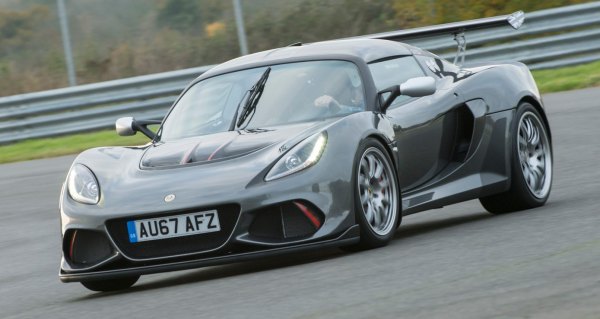
|
|
Upgraded
power, chassis and aero lift the Exige to another level.
|
|
Lotus gets more and more
expensive these days. Following the £112,500 Evora GT430, Exige
Cup 430 is another car selling at 6-figures price. Starting at
£100,000 before options, it is significantly more expensive than
the Exige Sport 350 (£57,200) and Sport 380 (£68,500) still
being sold. The new Porsche 911 GT3 4.0 is just £11,000
more. Who would buy the spartan Lotus?
Track day lovers, of course! If you pursue maximum performance and
thrills on track, the Exige Cup 430 is one of the best weapons at any
money. Its power-to-weight ratio is 400hp per ton, 50 more than the 911
GT3. Its massive aero kits produce 220 kg of downforce at 180 mph. Its
Michelin PS Cup 2 tires, 285/30ZR19 at the rear, afford extraordinary
grip and traction. Its Nitron dampers are 3-way adjustable (rebound,
low-speed compression and high-speed compression), ditto the anti-roll
bars, so you can always find the best setting for the particular track.
Its new AP brake discs with J-groove patterns offer tremendous stopping
power. No wonder it can lap Hethel’s own track in 1:24.8, some 3.2
seconds less than Sport 380. Even the latest Evora GT430 has to trail
it by a full second. In other words, it is the fastest Lotus road car
in the real world.
As suggested by its name, the car’s supercharged V6 produces 430 bhp or
436 hp (DIN), a quantum leap from the Sport 380. This is because the
engine is transplanted straight from the Evora GT430. Compared with the
old engine, its main difference is the larger supercharger and the
addition of a charge cooler, which barely fits the engine bay. Torque
is up by 23 lbft to 325, and it is available across a wide band between
2600 and 6800 rpm. This extra punch and flexibility is obvious on the
road, and you can use fewer gearchanges to keep the momentum.
Meanwhile, the power peak is stretched to 7000 rpm, freeing up the top
end and making a more purposeful sound through the titanium exhaust.
The car is now good for 180 mph, not bad considering its Cd of 0.42.
0-60 mph sprint is shortened to 3.2 seconds, again the quickest ever
for the brand.
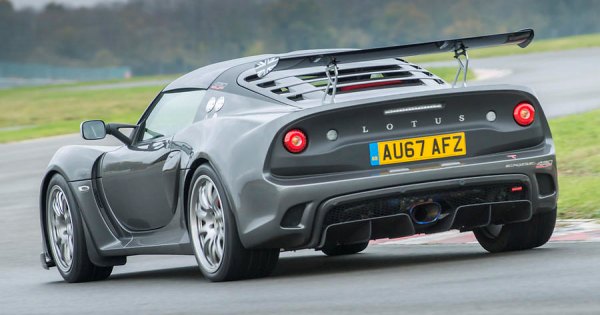
|
|
The
best driver’s car in the current lineup of Hethel, also one of the best
in the world.
|
|
The new engine, larger clutch and brakes add weight, but Lotus
compensates by using more carbon-fiber parts (tailgate,
bonnet, roof, aero kits, bucket seats and some interior trims), that
titanium exhaust (10kg loss) and by ditching air-con and
radio – yes, it is that purposeful. The result is 1093 kg kerb weight,
even lighter than the Sport 380.
Compared with that car, its aerodynamic design is obviously different.
The nose now features a more effective front splitter with end plates.
The intakes become larger, and they incorporate channels to generate
air curtains around the front wheels, reducing turbulence and drag.
Louvered vents are opened above the front fenders to release the
pressure built inside the wheel wells, contributing improved front-axle
downforce. At
the back, the new rear wing is wider and mounted higher to take
advantage of clean air flow.
As a track special, its ride is certainly stiffer than Sport 380.
B-road is not its natural playground, but it copes well. As long as you
don’t drive all-day long (the cockpit is too noisy for long journeys
anyway), you will still have plenty of fun attacking B-roads, thanks in
part to its compactness and good visibility. The unassisted steering
remains your most faithful yet talkative servant. The engine sounds
better and the power is more accessible, reducing the need to engage
that mediocre gearshift.
On track, the Cup 430 keeps the superb balance and agility the Exige
has always been famous for. You can sense the level of grip at both
ends from the steering, use those feedbacks to pivot the car and to
correct its attitude. Everything works in line with your basic instinct
– such is the great communication between man and machine. If anything
is different from lesser Exiges, it is the much enhanced grip level
hence superior cornering prowess. Moreover, in fast bend the aero adds
extra stability. Compared with Evora GT430, its lightness and
low center of gravity is obvious. It moves around less and corners even
faster. This is the best driver’s car in the current lineup of Hethel.
It is also one of the best driver’s cars in the world.
|
    
|
|